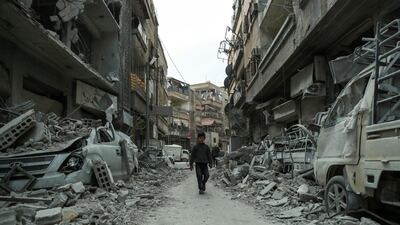A humanitarian convoy entered Syria's Eastern Ghouta during a lull in fighting on Friday but the delivery of aid was threatened by a resumption of shelling in the embattled rebel-held area near Damascus.
The International Committee of the Red Cross said a convoy of 13 trucks carrying food parcels for 12,000 people went into Douma – the largest and most populated town in the Eastern Ghouta.
The delivery consists of the remaining aid that was not offloaded during a humanitarian aid mission to the enclave on Monday which was cut short because of deteriorating security. The trucks had been stuck at the Wafideen crossing the entire week, waiting to enter to deliver the remaining food parcels and flour bags.
ICRC spokeswoman Indy Sedky said the trucks had crossed into Eastern Ghouta "after getting security guarantees from all parties to make sure no incident will happen during the presence of our team" there.
However, shelling later resumed Douma in what the UN humanitarian coordinator in Syria, Ali Al Zaatari, said was a breach of "assurances of safety from parties including the Russian Federation".
Friday's mission followed what opposition activists said was one of the quietest nights in Eastern Ghouta since Syrian government forces launched an offensive on the area on February 18. The government and its Russian backers intensified shelling and bombardment to clear the way for its troops to advance. More than 900 people have been killed in three weeks of relentless bombardment.
Government forces this week advanced from the east and were only about two kilometres away from linking with forces on the western side of Eastern Ghouta.
The military gains have caused large-scale internal displacement as civilians flee government advances toward areas in the territory still held by the rebels.
Nearly 400,000 people are believed to be inside Eastern Ghouta. The most built-up and densely populated areas still under rebel control include the towns of Douma, Harasta, Jisreen, Kfar Batna, Saqba and Hamouria.
_______________
Read more:
Syria trip by German far-right stokes refugee tension
The mass return of refugees is not part of the Syrian regime’s survival plan
_______________
The Syrian Observatory for Human Rights reported air strikes on Douma and Jisreen just before the 13-truck convoy arrived Friday, following a several-hour lull. It said the lull was result of local negotiations brokered by unnamed Damascus businessmen with the government to try and reach a solution that would secure the exit of fighters and civilians from Eastern Ghouta.
State-run Syrian TV on Friday reported that "dozens of civilians" would likely get out of Eastern Ghouta, in addition to 13 gunmen who had turned themselves in, via the Wafideen safe corridor designated by the government. The outlet has been reporting since last week that rebels have prevented civilians from leaving.
The Britain-based Observatory, which monitors the Syria war through a network of activists on the ground, also reported that dozens of people from the town of Hamouria staged a demonstration holding Syrian flags and calling for the end to the fighting in the area.
There was no confirmation by any of the rebel groups based in Eastern Ghouta of negotiations to leave the area.

